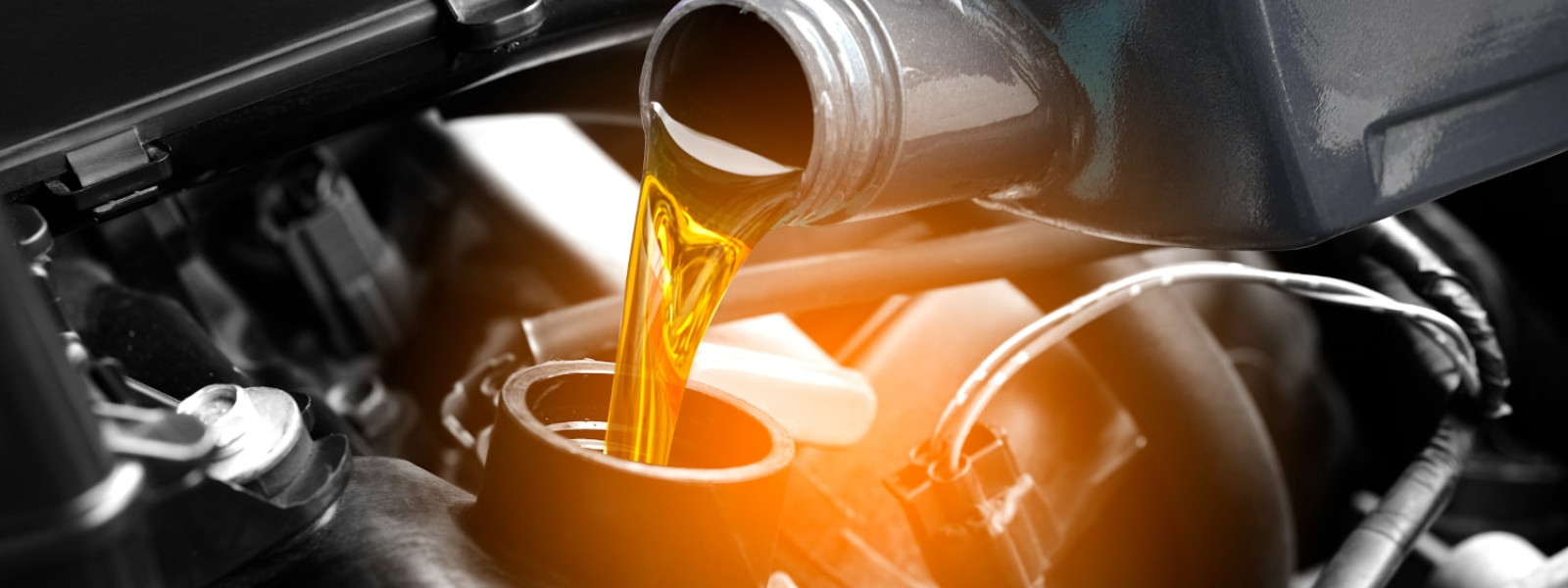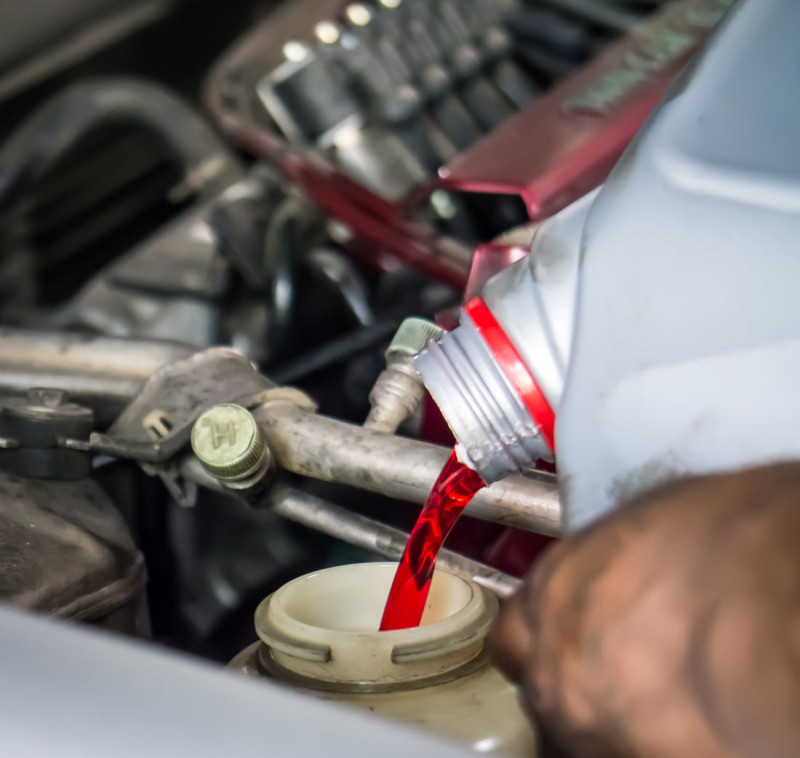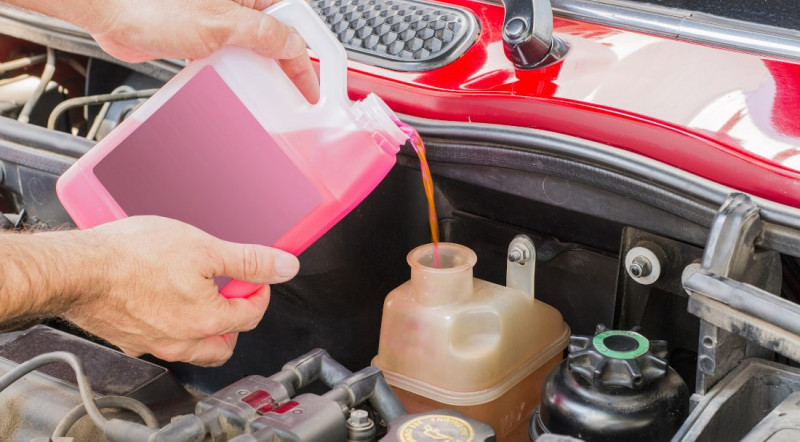Types of Fluids in Your Vehicle

Image Source: GettyImages
Key Takeaways
- There are seven essential fluids in every vehicle, including engine oil, transmission fluid, coolant, and brake fluid.
- Proper maintenance of car fluids is critical for vehicle safety, performance, and longevity.
- Climate-specific fluids are necessary for Ontario’s extreme seasonal conditions.
- Premium vehicle fluid specs must be followed for luxury brands like Bentley and Land Rover to avoid costly repairs.
- Regular fluid checks and timely changes improve efficiency and help prevent system failures.
- Windshield washer fluid, though often overlooked, is vital for safe driving visibility year-round.
Table of Contents
- What Are the Main Types of Fluids in a Car?
- Engine Oil: The Most Essential Engine Fluid
- Transmission Fluid: Keeping Your Gearbox Happy
- Brake Fluid: Safety in Every Stop
- Coolant / Antifreeze: Protection Against GTA’s Extreme Temperatures
- Differential Fluid: Crucial for All-Wheel Drive Vehicles
- Power Steering Fluid: Effortless Control
- Windshield Washer Fluid: See Clearly Year-Round
- How to Check Fluids in Your Car
- Seasonal Fluid Requirements for Toronto & North York
- Premium Vehicle Fluid Specs: Why High-End Cars Demand More
- When and How Often to Change Car Fluids
- Keep Your Car and Its Fluids Running Smoothly
Proper vehicle maintenance starts with understanding the essential automotive fluids that keep your car operating smoothly. Neglecting to check or replace even one of them can lead to performance issues, overheating, or costly repairs. In a region like the GTA, where winter temperatures can dip below -20°C and summer heat can exceed 30°C, using climate‑specific fluids becomes critical. Seasonal shifts place extra demand on both the fluid quality and replacement schedule.
It’s also worth noting that premium vehicle fluid specs — for brands like Land Rover, Bentley, and Jaguar — often differ from those of standard vehicles. These models typically require OEM-approved fluids with specific viscosities and additives. If you're driving a high-end or classic car, using the correct engine fluid or brake fluid isn't just a recommendation — it’s a necessity.
What Are the Main Types of Fluids in a Car?
There are seven core fluids in every modern vehicle. Together, they play a crucial role in lubrication, cooling, hydraulic operation, and visibility. Neglecting even one can compromise safety, drivability, or long-term durability.
Below is a summary of the different types of fluids in a car:
| Fluid Name | Function |
|---|---|
| Engine Oil | Lubricates engine components |
| Transmission Fluid | Enables smooth gear changes |
| Brake Fluid | Transfers force in braking system |
| Coolant / Antifreeze | Regulates engine temperature |
| Differential Fluid | Lubricates gear in differential systems |
| Power Steering Fluid | Assists steering movement |
| Windshield Washer Fluid | Cleans windshield |
Understanding how many fluids are in a car and when to service them can prevent mechanical failures and support long-term performance. Each of these car fluids has its own lifespan, colour, and performance specification.
1. Engine Oil: The Most Essential Engine Fluid
The engine oil — often referred to as motor oil — is the lifeblood of your car. It reduces internal friction, carries away heat, and cleans away contaminants inside the engine.
What Is Oil Used for in a Car?
Engine oil performs multiple functions:
- Lubricates moving parts (pistons, crankshaft, valves)
- Prevents corrosion
- Helps seal gaps between engine components
- Aids in cooling by dissipating heat
Viscosity Grades for Ontario Climate
In Ontario’s climate, where winter and summer extremes are common, viscosity grades like 0W-20 or 5W-30 are essential. These numbers refer to how the oil flows at cold start temperatures (W = winter) and at high operating temperatures. A 0W-20 oil, for example, flows better in freezing conditions and protects the engine during cold starts.
Synthetic vs. Conventional Fluid
Modern cars — especially premium and high-performance models — benefit from synthetic oil. Here's a quick comparison:
| Type | Advantages | Best For |
|---|---|---|
| Synthetic Oil | Longer life, better high/low-temp performance | Luxury, turbocharged, or modern engines |
| Conventional Oil | Lower cost, shorter change interval | Older engines or basic vehicles |
“Choosing the best engine fluid isn't just about brand — it’s about matching the oil to your driving conditions and manufacturer requirements.” — Jonathan D., Westminster Motors Technician
For classic car restoration, using the correct viscosity and engine fluid type is especially important. Older engines often require non-detergent oils or specific mineral-based formulas that newer vehicles don’t.
In any case, regular engine fluid changes are the most critical step in keeping your car reliable and efficient.
2. Transmission Fluid: Keeping Your Gearbox Happy

Transmission fluid is responsible for lubricating the moving parts within your vehicle’s transmission system — whether automatic or manual. It helps reduce friction, cools internal components, and ensures smooth gear shifts. Without proper maintenance, transmission wear can result in erratic shifting, slipping, or even total failure.
Types of Transmission Fluids
There are different types of fluids used depending on the transmission system:
- ATF (Automatic Transmission Fluid) – for conventional automatic gearboxes.
- CVT Fluid (Continuously Variable Transmission) – for vehicles with CVT systems
- DCT Fluid (Dual-Clutch Transmission) – used in high-performance and luxury vehicles.
Each of these fluid types contains specific additives and viscosities designed to match the transmission’s mechanical properties. For instance, Land Rover service manuals often specify proprietary ZF transmission fluid that meets their gearboxes' high heat and pressure requirements.
Fluid Colour and Condition
Fresh transmission fluid is typically bright red, pink or gold, while older or contaminated fluid may appear brown or burnt in colour — an indication that a fluid change is due. If your gearbox hesitates or shifts harshly, this could be a sign of degraded auto fluid.
Replacement Intervals for GTA Conditions
In the GTA, where urban traffic, steep temperature swings, and stop-and-go driving are common, transmission fluid should generally be changed between 50,000 to 160,000 km, or per manufacturer recommendations. Regular maintenance is especially critical for luxury or performance vehicles.
3. Brake Fluid: Safety in Every Stop
Of all vehicle fluids, brake fluid plays the most direct role in your safety. It transfers force from the brake pedal to the calipers using a hydraulic system. If this fluid is contaminated or degraded, it can significantly reduce stopping power, especially in emergencies.
Types of Brake Fluids and Their Differences
There are several brake fluid types based on DOT (Department of Transportation) ratings:
- DOT 3 – Glycol-based; absorbs moisture quickly.
- DOT 4 – Higher boiling point than DOT 3; suitable for modern vehicles.
- DOT 5.1 – Similar to DOT 4 but with higher thermal performance.
- DOT 5 – Silicone-based and not compatible with ABS systems.
Tip: Never mix different brake fluids without consulting your vehicle’s specifications. Compatibility is essential.
Climate and Contamination
Brake fluid is hygroscopic, meaning it absorbs moisture from the air. In climates like Toronto, with high humidity and winter salt exposure, this process accelerates. Moisture lowers the fluid’s boiling point, increasing the risk of brake fade. For that reason, most manufacturers recommend fluid replacement every 3 years.
Car fluid symbols on your dash (like the ABS or brake warning light) may indicate low fluid levels or contamination. During a pre-purchase car inspection, brake fluid should always be tested for moisture content and colour.
4. Coolant / Antifreeze: Protection Against GTA’s Extreme Temperatures

Coolant, also known as antifreeze, is crucial for maintaining safe engine temperatures in all seasons. It circulates through the radiator and engine block, removing excess heat in summer and preventing internal freezing in winter. Without it, your engine can overheat, seize, or crack.
Types of Coolant
Modern coolants are not universal. There are three main types used depending on vehicle age and make:
- IAT (Inorganic Additive Technology) – Found in older vehicles, usually green in colour.
- OAT (Organic Acid Technology) – Typically orange or dark green; used in most newer domestic and Asian vehicles.
- HOAT (Hybrid Organic Acid Technology) – Yellow, turquoise, or pink; used by European brands like BMW and Mercedes-Benz.
Using the wrong type or mixing coolant types can lead to corrosion, clogging, or overheating.
Why You Shouldn’t Use Water
In GTA winters, water alone isn’t sufficient — it freezes at 0°C, which can crack the engine block or radiator. Proper climate-specific fluids protect against temperatures down to -40°C and contain rust inhibitors to prolong component life.
Coolant also plays a key role in cabin heating. If your heater blows cold air in winter, degraded coolant or air pockets in the system may be to blame.
When to Replace
Coolant should be replaced every 2 to 5 years, depending on type and manufacturer specs. If you notice a rust-brown colour, low levels, or overheating, it’s time to flush and refill. Always check your owner's manual for OEM-approved products.
5. Differential Fluid: Crucial for All-Wheel Drive Vehicles
Often overlooked, differential fluid is vital in AWD, 4WD, and RWD vehicles. It lubricates the gears within the front and/or rear differentials, allowing your wheels to rotate at different speeds when turning or driving on uneven terrain.
Where It Matters Most
Vehicles like Land Rover, BMW xDrive, and Audi Quattro rely heavily on advanced differentials. Regular service is essential to protect the gear mesh, bearings, and seals in these systems — especially in off-road or winter conditions.
Types: GL-4 vs. GL-5
Differential fluids come in GL-4 and GL-5 classifications, referring to gear oil specifications:
- GL-4 – For synchronized manual transmissions or mild gear loading.
- GL-5 – For hypoid differentials, with higher pressure resistance.
Mixing these fluids — or using the wrong one — can cause gear wear or corrosion.
Service Intervals
Change intervals vary by vehicle but generally fall between 50,000 to 80,000 km. For high-torque vehicles or those driven in harsh conditions, shorter intervals may be required. Clean auto fluid in the differential ensures quiet operation and gear longevity.
6. Power Steering Fluid: Effortless Control
Power steering fluid enables smooth, responsive steering by creating hydraulic pressure within the steering rack system. Over time, exposure to heat, moisture, and contaminants can degrade the fluid, leading to steering issues or component damage.
ATF vs. Power Steering Fluid
Some vehicles use Automatic Transmission Fluid (ATF) for steering, while others require a dedicated power steering fluid. Using the wrong product may cause leaks or system failure, especially in cold climates like Ontario.
Tip: Check your owner's manual or consult a technician before topping up this fluid type.
Symptoms of Degraded Fluid
- Stiff or jerky steering
- Whining or groaning noise when turning
- Visible leaks near the steering reservoir or hoses
These signs may indicate it's time to replace your car fluid. Consistent performance depends on keeping this system sealed and clean.
When to Replace
Check fluid levels monthly and replace the fluid every 2–3 years or per the vehicle’s service schedule. In older models, dark or foamy fluid is a clear sign it’s past due for a change.
7. Windshield Washer Fluid: See Clearly Year-Round
While it might seem minor, windshield washer fluid is one of the most frequently used fluids in a car — especially in the GTA, where road salt, slush, bugs, and pollen all impair visibility.
Winter vs. Summer Formulas
In Canada, it’s important to use the seasonal formulation:
- Winter fluid contains anti-freeze agents to prevent freezing in the reservoir and nozzles (rated to -40°C).
- Summer fluid is designed to remove bug splatter and road film more effectively.
Avoid using plain water — it can freeze and crack washer lines or nozzles during winter months.
Signs of a Problem
- Weak spray or no spray at all
- Frozen nozzles in winter
- White residue or streaks on the windshield
These issues typically stem from low fluid quality or running the system dry.
Check and Fill
This is the easiest fluid to check — most reservoirs are clearly marked and translucent. Top up monthly, and before long drives or winter weather. Using a quality fluid for car visibility ensures safe driving in all conditions.
How to Check Fluids in Your Car
Knowing how to check fluids in your car is a basic but essential skill for every vehicle owner. Regular checks help identify issues early — before they become costly repairs or safety hazards.
General Guidelines
Here are basic steps to check the most common vehicle fluids:
- Engine Oil:
- Use the dipstick with the engine off and cool.
- Oil should be between the "Min" and "Max" markers and amber in colour.
- Dark or gritty oil? Time for a change.
- Transmission Fluid (automatic):
- Check with engine running (unless manual says otherwise).
- Look for clear red or pink fluid.
- Dark or burnt smell indicates wear.
- Brake Fluid:
- Locate the reservoir on the master cylinder.
- Fluid should be clear or light yellow.
- If it’s dark — replace it.
- Coolant / Antifreeze:
- Only check when engine is cold.
- Reservoir should show fluid between “Min” and “Max.”
- Milky or rusty colour = contamination.
- Power Steering Fluid:
- Check dipstick cap or sight window on reservoir.
- Low levels or dark fluid suggest service is needed.
- Windshield Washer Fluid:
- Translucent reservoir makes level checking easy.
- Refill with season-appropriate fluid as needed.
Dashboard Indicators & Symbols
Some fluids are monitored by sensors. Car fluid symbols such as the oil can, thermometer, or brake icon may appear on your dashboard when levels are low or quality is compromised.
Tip: A professional pre-purchase car inspection should always include a fluid condition check — especially for used luxury vehicles.
Seasonal Fluid Requirements for Toronto & North York
Ontario’s four-season climate requires adapting your automotive fluids to withstand both winter lows and summer highs. Seasonal fluid requirements are not just a suggestion — they’re a necessity for vehicle longevity and safety.
Winter Recommendations
- Engine Oil: Use low-viscosity grades like 0W-20 or 5W-30 for easy cold starts.
- Coolant / Antifreeze: Must be rated to -40°C or lower.
- Windshield Washer Fluid: Choose winter formula with anti-freeze additives.
- Brake Fluid: Moisture in the system can freeze — DOT 4 is better for cold resistance.
- Differential Fluid: Thinner synthetic gear oils reduce winter drivetrain strain.
Summer Recommendations
- Coolant: Vital to prevent overheating in stop-and-go GTA traffic.
- Transmission Fluid: Ensure it's fresh to avoid heat-related gear slippage.
- Engine Oil: Maintain proper levels — higher operating temps increase oil breakdown.
- Power Steering Fluid: Heat expansion can cause leaks if the fluid is degraded.
Changing and monitoring fluids seasonally reduces wear, improves fuel efficiency, and ensures system reliability year-round.
Premium Vehicle Fluid Specs: Why High-End Cars Demand More
Luxury and performance vehicles such as Bentley, Jaguar and Land Rover are engineered to higher tolerances and their premium vehicle fluid specs reflect that. Using substandard fluids can void warranties, reduce performance, or even damage expensive systems.
OEM Approvals & Special Requirements
High-end vehicles often require:
- OEM-certified engine fluids, such as VW 502.00, BMW LL-01, or Mercedes-Benz 229.5
- ZF transmission fluids for 8-speed automatic gearboxes in Land Rover and Audi
- Silicone-based DOT 5 brake fluids for ultra-high-performance systems (not interchangeable with DOT 3/4)
Why It Matters
- Engine Fluid: Synthetic oil with high thermal stability ensures protection at extreme RPMs.
- Brake Fluid: Precision braking requires consistent pressure and heat resistance.
- Coolant: Specific formulations prevent corrosion in aluminium-based engines.
Tip: Never top off a Bentley brake system with generic DOT 4 from a gas station — this can cause component failure or error codes.
If you drive a luxury or European vehicle, refer to the owner’s manual or consult a certified technician before choosing any oil & fluids.
When and How Often to Change Car Fluids
Replacing car fluids at proper intervals ensures optimal performance and avoids system damage. Here's a general overview of how many fluids need to be changed in a car — and when.
| Fluid | Typical Change Interval | Notes |
|---|---|---|
| Engine Oil | Every 5,000–12,000 km | Shorter intervals for conventional oil |
| Transmission Fluid | Every 50,000–160,000 km | CVT and DCT may require OEM fluids and tighter schedules |
| Brake Fluid | Every 3 years or 40,000 km | Replace if water content exceeds 2% |
| Coolant / Antifreeze | Every 2–5 years | Check freeze point and colour annually |
| Differential Fluid | Every 50,000–80,000 km | Shorter for AWD or off-road vehicles |
| Power Steering Fluid | Every 2–3 years | Look for colour change or noise |
| Windshield Washer Fluid | As needed (check monthly) | Use seasonally appropriate fluid |
You don’t need to remember each number, your vehicle’s maintenance manual provides official guidance. But if you’re unsure, a fluid inspection at a reputable service centre like Westminster Motors ensures everything stays within spec.
Keep Your Car and Its Fluids Running Smoothly
Fluids are more than just maintenance items — they’re the foundation of your vehicle’s reliability and safety. From engine lubrication to winter visibility, every car fluid plays a role in long-term performance.
Whether you're navigating summer heat or preparing for a harsh Ontario winter, don't underestimate the power of a fluid check. For premium and imported vehicles in particular, using the correct premium vehicle fluid specs is not optional — it's essential.
Book a diagnostic check at Westminster Motors to ensure your fluids are in top shape, especially if you're driving a Land Rover, Bentley, or other high-performance vehicle. Our certified technicians will inspect, flush, and replace all critical fluids using OEM-approved products.
Author: Avo Demirjian